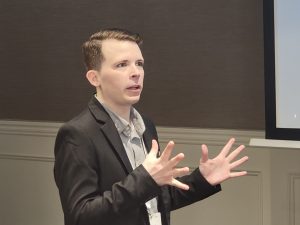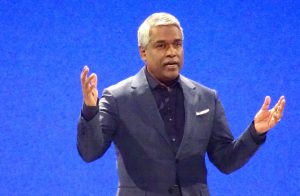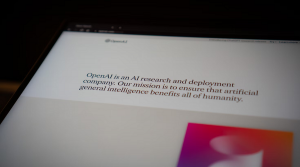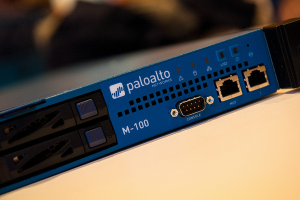Self-disruption keeps Nutanix nimble as IPO buzz returns | #vmworld
![]() Dheeraj Pandey believes his company, Nutanix, Inc. CEO, is just beginning to blossom and will continue to expand. At this week’s VMworld 2014 conference, there’s been a buzz about Nutanix’s most recent financing round of $140 million, announced this morning. In conversation with Dave Vellante and John Furrier at SiliconANGLE’s roving news desk theCUBE, Pandey expounded on aspects of the recent Nutanix funding round, the reasons for his company’s success, and his predictions for the future of Nutanix.
Dheeraj Pandey believes his company, Nutanix, Inc. CEO, is just beginning to blossom and will continue to expand. At this week’s VMworld 2014 conference, there’s been a buzz about Nutanix’s most recent financing round of $140 million, announced this morning. In conversation with Dave Vellante and John Furrier at SiliconANGLE’s roving news desk theCUBE, Pandey expounded on aspects of the recent Nutanix funding round, the reasons for his company’s success, and his predictions for the future of Nutanix.
Nutanix Funding: a pre-IPO
In this most recent round of funding, Pandey said that his business focused on building a relationship “with the best investors who buy into the IPO as well.” It was about the character of investors.
Calling Nutanix’s most recent round of funding a “pre-IPO,” Furrier wondered whether anybody sold their shares of Nutanix. Pandey replied that, in fact, no one had sold. “People believe in this company,” he said. Employees and stakeholders understand that while Nutanix is boxed into the same category as hyper-converge right now, it will break down the category barriers and continue to grow.
Read much more after the video.
The need for integration will sustain Nutanix performance
Now that Nutanix has received another massive round of funding, Furrier asked, how will they sustain their performance? Responding that their role in storage trends has largely to do with integration, Pandey explained “it’s about seamlessly integrating everything together.” If the trend is self service apps, he said, then “they need self-service ways to deal with performance issues.”
He cited the example of Docker, saying that it’s an excellent orchestration tool, but once everything is provision, “now what?” Nutanix can help with the “hand-holding” to aid practitioners in figuring out “why it’s running slow or what needs to move. There are a ton of analytics to be done.”
Once provisioning is done, Furrier pointed out, there still needs to be an enabler for the developer to ensure that “the infrastructure isn’t going to break.” Pandey agreed, saying that when apps are decoupled from infrastructure, “you still have to live with infrastructure. An app will not just run in a vacuum.” Docker, he said, is a great mechanism, but Nutanix will help put policies on top of it.
For Nutanix realationships, transparency are key
Nutanix is more transparent with its numbers than many other players in the tech world, if you ask Pandey. One of the reasons Nutanix chooses to be so transparent is because of it’s confidence in its products. “We’re very comfortable with Dell carrying an EVO RAIL platform and carrying an Nutanix,” said Pandey, going on to note his dedication to the market. “This is a marathon,” he said, and eventually the dust will settle and the top product will still be standing.
Nutanix is very open about its numbers with customers. It might not always be that way, he acknowledged, but right now, “We won’t let the lawyers run the company.” Pandey communicated that their customers love that amount of transparency because it communicates that Nutanix isn’t hiding anything: they’re proud of the company. Nutanix even openly addresses its weaknesses, and Pandey expressed that he thinks it makes them a better company.
As of July 31st, Pandey relayed, Nutanix has “800 customers. We’re adding 200 to 250 logos a quarter. And we have a lot of repeat customers.” In the first twelve months after their initial purchase, Pandey said that about 70 percent of their customers come back to buy two times more.
Nutanix in relation to other players
![]() While the tech industry continues to grow like gangbusters, Pandey said that good companies, like Nutanix and Cisco, will be able to coexist.
While the tech industry continues to grow like gangbusters, Pandey said that good companies, like Nutanix and Cisco, will be able to coexist.
The real issue, he called out, is not to be the desktop after the iPhone and Android came out. While the two smartphones warred away, the desktop faded into the background. According to Pandey, the technology that will fade into the background between Nutanix and VMware, Inc.’s recently launched hyper-convergence tool EVO:RAILs will be the SAN. Even VMware came out and said that “there’s no need for a SAN.”
Jumping off this notion, Furrier wondered why this was “the beginning of the end of the SAN.” The big reason SAN is waning, Pandey said, is “empowerment and liberation.” Microsoft, he said, is a great example. They offered these qualities in a big way with respect to Unix vendors and systems managers. “Liberation sells a lot,” he said. Human beings want empowerment.” And hyper convergence is an empowering technology — it’s a phenomena that allows administrators to make their own decisions.
Liberating aspects that Pandey followed were threefold: Virtualization is now mature, 10 gigabit ethernet can now converge networks, and flash had truly come into its own.
Attacking TAM with self-disruption
Citing Nutanix’s $400 billion Total Addressable Market (TAM), Vellante wondered how Nutanix will go about attaching that massive number. Why, he asked, will Nutanix be able to grow faster than legacy organizations like Oracle? Pandey replied by saying that Nutanix is constantly looking for ways to disrupt itself, “expanding the scope of applications, the use cases and workloads, all the TAM will come to us.” He cited their recent OEM deal with Dell as a recent example of Nutanix disrupting itself. They’re also constantly going after new workloads, he added, like exchange workloads, Microsoft Oracle, and NOSQL workloads.
Though many tech companies use similar marketing lingo, Pandey says it’s balance that makes Nutanix stand out. They’re dedicated to technology, customers, and their employees.
On the product side, Pandey communicated that consumer-grade design and web scale engineering are two of Nutanix’s most powerful strengths — “you get the right brain of apple and the left brain of Google” melded together and brought to the enterprise.
On the execution side, he said, “we really own support.” Their ability to respond to customers needs is a deep point of pride. “If we have empathy for stakeholders,” like customers, employees and partners, “I think eventually things will work out.” What Pandey doesn’t want is or Nutanix to value their stockholders more than stakeholders. “That’s when things start to go wrong,” he said.
And when it comes to employees in an age when automation and orchestration displace jobs, Nutanix invests in the education and enablement of its workers. “Today we have tons of people in the data center. Tomorrow we won’t have as many people in a datacenter.” Big Data, machine learning, and automation will make people obsolete in that area. In fact, Pandey said that at Nutanix, their goal is to make storage an invisible resource. As humans become less involved with machines, though, Nutanix help workers to retrain as part of the company’s overall initiative.
Photos by SiliconANGLE
A message from John Furrier, co-founder of SiliconANGLE:
Your vote of support is important to us and it helps us keep the content FREE.
One click below supports our mission to provide free, deep, and relevant content.
Join our community on YouTube
Join the community that includes more than 15,000 #CubeAlumni experts, including Amazon.com CEO Andy Jassy, Dell Technologies founder and CEO Michael Dell, Intel CEO Pat Gelsinger, and many more luminaries and experts.
THANK YOU













